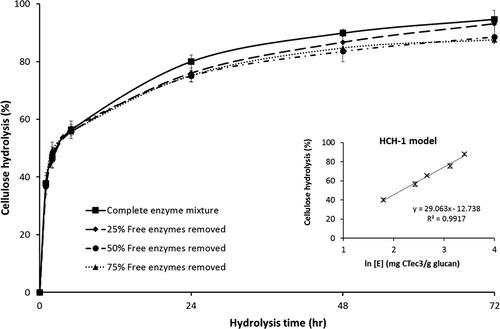当前位置:
X-MOL 学术
›
ACS Sustain. Chem. Eng.
›
论文详情
Our official English website, www.x-mol.net, welcomes your
feedback! (Note: you will need to create a separate account there.)
Can We Reduce the Cellulase Enzyme Loading Required To Achieve Efficient Lignocellulose Deconstruction by Only Using the Initially Absorbed Enzymes?
ACS Sustainable Chemistry & Engineering ( IF 7.1 ) Pub Date : 2018-04-12 00:00:00 , DOI: 10.1021/acssuschemeng.8b00004 Jinguang Hu 1 , Yiu Ki Mok 1 , John N. Saddler 1
ACS Sustainable Chemistry & Engineering ( IF 7.1 ) Pub Date : 2018-04-12 00:00:00 , DOI: 10.1021/acssuschemeng.8b00004 Jinguang Hu 1 , Yiu Ki Mok 1 , John N. Saddler 1
Affiliation

|
The cost-effective production of sugars from biomass continues to be challenging, partly due to the relatively high enzyme/protein loading required to achieve effective hydrolysis of the insoluble polysaccharides within the pretreated lignocellulosic substrates. Previous work has suggested that those enzymes that initially, strongly adsorb to the insoluble substrate are crucial for effective cellulose hydrolysis. However, most previous work in this topic area has used either purified enzymes or “older” generations of cellulase preparations acting on “model” cellulosic substrates. The results were, in several cases, contradictory or inconclusive. In the work reported here, the roles and functions of the initially adsorbed enzymes in determining the rate and extent of cellulose hydrolysis were assessed when using several different pretreated biomass substrates and the Novozyme enzyme preparation, Cellic CTec3. It was apparent that the initially adsorbed enzymes (irreversible bound to substrate after centrifugation) played a critical role as the removal of the “free/unadsorbed” enzymes in solution resulted in no significant decrease in the rate and extent of cellulose hydrolysis, regardless of the enzyme loading and the substrates used. By removing the initially, “free/unadsorbed” enzyme, the enzyme loadings required for an effective biomass deconstruction (>70% cellulose hydrolysis yields within 3 days) could be reduced by up to 50%, depending on the substrate used.
中文翻译:

我们是否可以仅通过使用最初吸收的酶来减少实现有效的木质纤维素解构所需的纤维素酶负荷?
从生物质中低成本地生产糖继续具有挑战性,部分原因是为了实现预处理的木质纤维素底物中的不溶性多糖的有效水解,需要相对较高的酶/蛋白质负载量。先前的工作表明,那些最初强烈吸附到不溶性底物上的酶对于有效的纤维素水解至关重要。但是,该主题领域以前的大多数工作都使用了纯化的酶或作用在“模型”纤维素底物上的“旧”世代纤维素酶制剂。在某些情况下,结果是矛盾的或不确定的。在这里报道的作品中,当使用几种不同的预处理生物质底物和Novozyme酶制剂Cellic CTec3时,评估了最初吸附的酶在确定纤维素水解速率和程度方面的作用和功能。显然,最初吸附的酶(离心后不可逆地结合在底物上)起着关键作用,因为去除溶液中“游离/未吸附”的酶不会导致纤维素水解速率和程度的显着降低,无论酶的上样量和所用的底物。通过去除最初的“游离/未吸附”酶,有效的生物质解构(3天之内纤维素水解率> 70%)所需的酶负载量最多可降低50%,具体取决于所用的底物。蜂窝CTec3。显然,最初吸附的酶(离心后不可逆地结合在底物上)起着关键作用,因为去除溶液中“游离/未吸附”的酶不会导致纤维素水解速率和程度的显着降低,无论酶的上样量和所用的底物。通过去除最初的“游离/未吸附”酶,有效的生物质解构(3天之内纤维素水解率> 70%)所需的酶负载量最多可降低50%,具体取决于所用的底物。蜂窝CTec3。显然,最初吸附的酶(离心后不可逆地结合在底物上)起着关键作用,因为去除溶液中“游离/未吸附”的酶不会导致纤维素水解速率和程度的显着降低,无论酶的上样量和使用的底物。通过去除最初的“游离/未吸附”酶,有效的生物质解构(3天之内纤维素水解率> 70%)所需的酶负载量最多可降低50%,具体取决于所用的底物。显然,最初吸附的酶(离心后不可逆地结合在底物上)起着关键作用,因为去除溶液中“游离/未吸附”的酶不会导致纤维素水解速率和程度的显着降低,无论酶的上样量和使用的底物 通过去除最初的“游离/未吸附”酶,有效的生物质解构(3天之内纤维素水解率> 70%)所需的酶负载量最多可降低50%,具体取决于所用的底物。显然,最初吸附的酶(离心后不可逆地结合在底物上)起着关键作用,因为去除溶液中“游离/未吸附”的酶不会导致纤维素水解速率和程度的显着降低,无论酶的上样量和使用的底物。通过去除最初的“游离/未吸附”酶,有效的生物质解构(3天之内纤维素水解率> 70%)所需的酶负载量最多可降低50%,具体取决于所用的底物。
更新日期:2018-04-12
中文翻译:

我们是否可以仅通过使用最初吸收的酶来减少实现有效的木质纤维素解构所需的纤维素酶负荷?
从生物质中低成本地生产糖继续具有挑战性,部分原因是为了实现预处理的木质纤维素底物中的不溶性多糖的有效水解,需要相对较高的酶/蛋白质负载量。先前的工作表明,那些最初强烈吸附到不溶性底物上的酶对于有效的纤维素水解至关重要。但是,该主题领域以前的大多数工作都使用了纯化的酶或作用在“模型”纤维素底物上的“旧”世代纤维素酶制剂。在某些情况下,结果是矛盾的或不确定的。在这里报道的作品中,当使用几种不同的预处理生物质底物和Novozyme酶制剂Cellic CTec3时,评估了最初吸附的酶在确定纤维素水解速率和程度方面的作用和功能。显然,最初吸附的酶(离心后不可逆地结合在底物上)起着关键作用,因为去除溶液中“游离/未吸附”的酶不会导致纤维素水解速率和程度的显着降低,无论酶的上样量和所用的底物。通过去除最初的“游离/未吸附”酶,有效的生物质解构(3天之内纤维素水解率> 70%)所需的酶负载量最多可降低50%,具体取决于所用的底物。蜂窝CTec3。显然,最初吸附的酶(离心后不可逆地结合在底物上)起着关键作用,因为去除溶液中“游离/未吸附”的酶不会导致纤维素水解速率和程度的显着降低,无论酶的上样量和所用的底物。通过去除最初的“游离/未吸附”酶,有效的生物质解构(3天之内纤维素水解率> 70%)所需的酶负载量最多可降低50%,具体取决于所用的底物。蜂窝CTec3。显然,最初吸附的酶(离心后不可逆地结合在底物上)起着关键作用,因为去除溶液中“游离/未吸附”的酶不会导致纤维素水解速率和程度的显着降低,无论酶的上样量和使用的底物。通过去除最初的“游离/未吸附”酶,有效的生物质解构(3天之内纤维素水解率> 70%)所需的酶负载量最多可降低50%,具体取决于所用的底物。显然,最初吸附的酶(离心后不可逆地结合在底物上)起着关键作用,因为去除溶液中“游离/未吸附”的酶不会导致纤维素水解速率和程度的显着降低,无论酶的上样量和使用的底物 通过去除最初的“游离/未吸附”酶,有效的生物质解构(3天之内纤维素水解率> 70%)所需的酶负载量最多可降低50%,具体取决于所用的底物。显然,最初吸附的酶(离心后不可逆地结合在底物上)起着关键作用,因为去除溶液中“游离/未吸附”的酶不会导致纤维素水解速率和程度的显着降低,无论酶的上样量和使用的底物。通过去除最初的“游离/未吸附”酶,有效的生物质解构(3天之内纤维素水解率> 70%)所需的酶负载量最多可降低50%,具体取决于所用的底物。










































 京公网安备 11010802027423号
京公网安备 11010802027423号